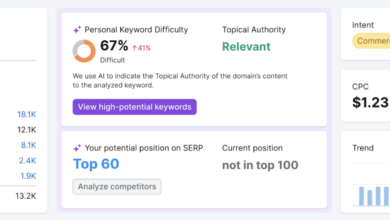
SEO Content Gap Analysis A Deep Dive
Seo content gap analysis – content gap analysis is crucial for optimizing your online presence. It involves meticulously identifying areas where your website’s content falls short, compared to both your target audience’s needs and the strategies of your competitors. This analysis is a vital step in creating a more effective content strategy, ultimately improving search engine rankings and user experience.
By understanding the different types of content gaps – informational, transactional, and navigational – you can tailor your content to precisely address the needs of your audience. This comprehensive process helps you understand your current content’s strengths and weaknesses, allowing you to fill the gaps and elevate your website’s visibility and overall performance.
Defining Content Gaps
Content gaps are critical voids in a website’s online presence that prevent it from effectively reaching its target audience and achieving its marketing goals. They represent opportunities to improve and user experience by filling in the missing pieces of the online puzzle. Understanding and addressing these gaps is essential for optimizing a website and driving better results.Identifying and filling these gaps is vital for website optimization because they often indicate areas where the website isn’t meeting user needs or search engine expectations.
Missing content can lead to lower search engine rankings, decreased traffic, and ultimately, a less effective online presence. By understanding these gaps, businesses can strategically create new content to address these shortcomings and improve their visibility and performance.
Content Gap Types
Content gaps aren’t a one-size-fits-all issue. They manifest in various forms, each reflecting a specific user need or search intent. Recognizing these different types allows for a more targeted approach to filling the gaps and optimizing the website.
- Informational content gaps occur when a website lacks content that answers common user questions or provides detailed explanations about specific topics. For example, a website selling hiking boots might lack a comprehensive guide on choosing the right hiking boots for different terrains. This leaves potential customers searching elsewhere for the information they need.
- Transactional content gaps refer to the absence of content that guides users through the purchase process. A clear call to action, detailed product descriptions, and secure checkout procedures are critical for conversions. A website might have excellent product pages but lack detailed shipping and return policies, creating friction in the sales funnel.
- Navigational content gaps relate to the website’s structure and ease of navigation. A confusing or poorly organized site can lead users to become frustrated and leave without completing their desired action. An e-commerce site lacking a user-friendly search function or clear product categories will lose potential customers.
Impact on Search Engine Rankings
Search engines like Google prioritize websites that offer comprehensive and relevant content. Content gaps directly affect search engine rankings because they signal to search engines that the website is incomplete or doesn’t fully address user needs. This can lead to lower rankings in search results, reducing visibility and organic traffic. For instance, a travel blog lacking content about budget-friendly destinations might rank lower than competitors who cover this niche.
Importance for User Experience
Content gaps significantly impact user experience. Incomplete or irrelevant information creates a frustrating experience for visitors, leading to higher bounce rates and lower engagement. If a website is missing key information about a product or service, users will likely seek the necessary information elsewhere. By addressing content gaps, businesses create a seamless and satisfying experience for visitors.
Content Gap Classification Framework
A robust framework for classifying content gaps is crucial for effective website optimization. A framework based on user intent can guide the creation of targeted content. The framework can be structured to classify content gaps based on user search queries, motivations, and goals.
| User Intent | Example Search Query | Corresponding Content Gap Type |
|---|---|---|
| Informational | “best hiking boots for beginners” | Informational |
| Transactional | “buy hiking boots under $100” | Transactional |
| Navigational | “hiking boot store near me” | Navigational |
Identifying Target Audience Needs: Seo Content Gap Analysis

Understanding your target audience is crucial for creating effective content. Knowing their needs, interests, and search behavior allows you to tailor your content to resonate with them, improving organic search rankings and driving engagement. This process isn’t just about guessing; it’s about actively listening and responding to their demands. By identifying the specific pain points and information gaps your audience faces, you can fill them with valuable content that positions you as a trusted resource.A deep understanding of audience needs goes beyond basic demographics.
It involves uncovering their motivations, challenges, and the specific questions they’re searching for answers to. This in-depth knowledge allows for the creation of content that directly addresses their needs, establishing a strong connection with the target audience.
Methods for Discovering Audience Needs
Understanding your audience goes beyond surface-level data. It requires exploring various methods for uncovering their specific needs. Qualitative research methods, like surveys and interviews, provide rich insights into their motivations and frustrations. These methods allow for a deeper understanding of the ‘why’ behind their search queries, enabling you to create content that resonates on a deeper level.
Analyzing Audience Behavior
Understanding how your audience behaves online is crucial for identifying their needs. Tools like Google Analytics and Search Console offer valuable insights into user behavior, including popular search terms, bounce rates, and time spent on specific pages. This data helps you understand what content resonates and what falls flat. Examining click-through rates (CTR) on search results pages is another key metric.
High CTR indicates that your content effectively addresses user needs.
Segmenting Audiences Based on Search Intent
Search intent varies significantly, from informational queries to transactional ones. Segmenting your audience based on search intent allows for tailored content strategies. For example, a user searching for “best running shoes for plantar fasciitis” likely has a transactional intent. Your content should address this intent by presenting a clear comparison and recommendation. Conversely, a user searching for “what is plantar fasciitis” has an informational intent.
Your content strategy should provide comprehensive information about the condition.
Comparing Data Sources
Various data sources offer insights into audience preferences. Social media analytics, forums, and review sites provide invaluable data regarding trending topics and common concerns. Combining data from different sources allows for a more comprehensive understanding of your audience. For example, if social media trends show a surge in questions about a specific topic, coupled with high search volume for similar queries, you can prioritize that area for content creation.
This data allows for a nuanced and comprehensive understanding of audience preferences.
Organizing a Process for Identifying Content Gaps
A structured process for identifying content gaps is essential. Begin by compiling a list of all relevant s and search terms. Next, analyze your existing content and identify areas where there is a lack of comprehensive information. Then, review the data collected from your audience analysis. Compare the research with the audience data.
The comparison helps highlight content gaps.
Interpreting Audience Data to Identify Content Gaps
Interpreting audience data involves identifying patterns and trends in search queries and user behavior. A high volume of searches for a specific topic, coupled with low engagement on existing content, points to a significant content gap. Understanding the difference between search intent and user behavior helps identify the specific needs your content should address. For example, if users are searching for “how to fix a leaky faucet” but are not finding sufficient instructions, this highlights a need for more detailed, step-by-step guides.
Analyzing Competitor Strategies

Understanding your competitors’ content strategies is crucial for identifying gaps in your own offerings and tailoring your content to better meet your target audience’s needs. By analyzing their strengths and weaknesses, you can avoid duplication, pinpoint underserved niches, and optimize your approach to achieve higher rankings and more engagement. This proactive approach allows you to strategically position your content as a valuable resource, differentiating it from the competition.A comprehensive competitor analysis delves into their content creation, promotion, and performance, providing actionable insights for refining your own strategy.
This involves evaluating their content’s effectiveness in terms of reach, engagement, and conversion rates. By understanding their strategies, you can discover gaps in the market and develop unique content that stands out.
Importance of Studying Competitor Content Strategies
Analyzing competitor content strategies provides a benchmark for evaluating your own efforts. It allows you to identify content formats, topics, and styles that resonate with your target audience. This competitive intelligence is invaluable for crafting a content strategy that effectively addresses the needs and interests of your audience while differentiating your content from similar offerings. This in turn leads to improved rankings and a greater return on investment (ROI) from your content marketing efforts.
Methods to Identify Content Gaps in Competitor Websites
Thorough website audits of competitor sites are essential. These audits should examine the type and quantity of content published, the frequency of updates, and the overall structure of the site. Tools like SEMrush, Ahrefs, and Moz can help analyze backlinks, s, and traffic data to understand how competitors are performing. Looking at the topics they cover and the depth of information provided can reveal gaps in their coverage.
This can provide insight into potential niches or angles you can exploit to provide more comprehensive and engaging content. A detailed competitor content audit helps identify gaps and potential opportunities.
Techniques to Compare and Contrast Competitor Content
Categorize competitor content by topic, format, and target audience. Analyze the tone, style, and voice of each piece. Compare the length, structure, and s used. This comparative analysis reveals the strengths and weaknesses of each competitor’s content approach. Note the level of engagement each competitor is receiving, such as comments, shares, and social media interactions.
By identifying common themes, you can better understand your target audience and tailor your content to meet their needs. A systematic comparison helps identify the most effective strategies for each niche.
Different Ways to Analyze the Effectiveness of Competitor Content
Evaluate competitor content based on factors like search engine rankings, social media engagement, and website traffic. Analyzing their backlinks and social shares reveals the extent of their content’s influence. Use analytics tools to measure the performance of specific content pieces. This allows you to assess their impact on the target audience and identify what strategies are working for them.
Figuring out SEO content gaps can be tricky, but understanding what your competitors are missing is key. To effectively identify those gaps, researching popular products on Amazon is essential. Tools like 10 best amazon product research tools online help you uncover trending products and uncover potential keywords that are currently underserved in the market. This analysis will help you create content that fills those gaps and attracts a bigger audience.
For example, if a competitor’s blog posts consistently rank highly in search results, it suggests a successful strategy.
Value of Understanding Competitor Content Strategies
Understanding competitor content strategies allows you to gain a clearer picture of the market landscape and position your content for success. This competitive intelligence helps you anticipate audience needs, tailor your content to address those needs, and avoid creating redundant or irrelevant content. By analyzing their strengths and weaknesses, you can strategically position your content to fill any existing gaps in the market and achieve a higher ranking.
Ultimately, understanding your competitors allows you to develop a robust content strategy that yields a better return on your investment.
Table Comparing Competitor Content Performance
| Competitor | Niche | Content Format | Engagement Metrics (e.g., Social Shares, Comments) | Ranking |
|---|---|---|---|---|
| Company A | E-commerce | Product Reviews, Blog Posts | High | Top 3 |
| Company B | Finance | Educational Articles, Case Studies | Moderate | Top 10 |
| Company C | Health & Fitness | Videos, Infographics | Very High | Top 5 |
This table presents a simplified comparison of competitor content performance. Real-world data would include more granular metrics and a larger sample size of competitors.
Prioritizing Content Gaps
Identifying and analyzing content gaps is only half the battle. The true challenge lies in prioritizing these gaps to maximize the return on investment (ROI) of your content creation efforts. A well-defined prioritization strategy ensures you focus on the most impactful content first, driving the greatest results with the least amount of effort.Effective prioritization involves understanding the potential impact of each gap, the resources required to fill it, and aligning the content with broader business objectives.
This process is crucial for allocating resources wisely and achieving significant results.
Significance of Prioritization
Prioritizing content gaps is essential to ensure that the most impactful content is created first. This strategic approach allows for a more efficient allocation of resources, focusing on the highest-value opportunities. By targeting the most critical gaps, you can achieve maximum impact with your content marketing efforts.
Evaluating Potential Impact, Seo content gap analysis
Assessing the potential impact of addressing a content gap involves several key factors. Quantifiable metrics can help determine the value of each gap. For example, a content gap addressing a high-volume search query with low competition has a higher potential impact than a gap addressing a less popular query. Understanding the potential traffic, leads, and conversions that can be generated from addressing a gap is crucial.
Metrics for Measuring Content Gap Importance
Several metrics can be used to evaluate the significance of a content gap. Search volume, difficulty, existing competitor content, and the potential for lead generation are key indicators. For instance, a content gap addressing a high-volume search query with low competition, and a high level of engagement with similar content on the competitor’s website, suggests a higher priority.
A content gap with low search volume and high competition, on the other hand, will likely yield less impactful results.
- Search volume: Indicates the frequency of user searches for a specific topic or . Higher volume suggests greater potential reach.
- difficulty: Measures the level of competition for a specific . Lower difficulty suggests easier ranking and greater potential for visibility.
- Competitor analysis: Evaluating competitor content allows for the identification of gaps in their strategies and provides opportunities for differentiation.
- Lead generation potential: Assessing the potential for generating leads from a particular content piece based on the target audience and the value proposition.
Ranking Content Gaps Based on ROI
A system for ranking content gaps based on potential ROI involves a weighted scoring system. Factors like search volume, difficulty, existing competitor content, and the potential for lead generation can be assigned weights based on their relative importance. This approach creates a standardized method for comparing and ranking various content gaps. For example, a gap addressing a high-volume, low-difficulty , directly related to a high-value product or service, could receive a higher score than one addressing a low-volume, high-difficulty .
Alignment with Business Objectives
Prioritization must align with overall business objectives. Content gaps should be evaluated in relation to their contribution to key performance indicators (KPIs), such as increased brand awareness, lead generation, or sales. For instance, a content gap addressing a critical FAQ regarding a new product launch directly contributes to a company’s sales goals and should receive a higher priority than a gap addressing a less pertinent topic.
Figuring out SEO content gaps is crucial for website success. But, thinking outside the box can unlock even more opportunities. Consider how targeting specific demographics on platforms like TikTok ads can uncover content niches you might not have previously considered. This data can then inform your SEO content gap analysis, helping you create content that truly resonates with your audience.
Prioritized List of Content Gaps
| Content Gap | Estimated Effort (Hours) | Estimated Value (Potential ROI) | Priority Ranking |
|---|---|---|---|
| Comprehensive guide to using software X | 100 | $5,000 | High |
| Case studies showcasing successful implementations of software Y | 50 | $2,000 | Medium |
| FAQ page for the new product Z | 20 | $1,500 | High |
| Blog post on industry trends | 10 | $500 | Low |
This table provides a simplified example of a prioritized list of content gaps. The estimated effort and value are approximations and can vary depending on specific factors. This is a dynamic list, and adjustments should be made as new information becomes available.
Developing Actionable Strategies
Bridging the gap between identifying content needs and actually creating it requires a well-defined strategy. This involves more than just listing topics; it demands a structured approach to content development, ensuring alignment with your target audience and business objectives. Effective strategies will not only fill content gaps but also drive engagement, build brand authority, and ultimately contribute to achieving your goals.Once the content gaps are pinpointed and the target audience’s needs are understood, formulating a concrete action plan is crucial.
This plan should detail the specific content formats, the desired impact, and the metrics for measuring success. The key is to move from identifying a problem to creating a solution that generates tangible results.
Formulating Strategies to Address Content Gaps
A comprehensive content strategy involves careful consideration of various factors. Understanding your target audience’s preferences and pain points is paramount. Analyzing competitor strategies provides valuable insights into what’s working for others in your niche, allowing you to identify unique angles and cater to unmet demands. Prioritizing content gaps based on their potential impact on key performance indicators (KPIs) will focus efforts on the most valuable assets.
Types of Content to Fill Identified Gaps
Various content formats can effectively address identified content gaps. Blog posts are an excellent way to provide in-depth information, establish expertise, and drive traffic. Videos can enhance engagement and cater to visual learners, while infographics are perfect for presenting complex data in a concise and visually appealing format. Consider also interactive content, such as quizzes or polls, to increase user interaction and knowledge retention.
Content Formats for Diverse Needs
- Blog Posts: Detailed articles addressing specific topics within your niche. Example: A comprehensive guide to strategies for e-commerce websites.
- Videos: Short, engaging video tutorials, explainer videos, or interviews with industry experts. Example: A step-by-step video demonstrating how to use a new software tool.
- Infographics: Visual representations of data, statistics, or processes. Example: An infographic comparing the success rates of different social media marketing strategies.
- Case Studies: Detailed accounts of successful projects or initiatives. Example: A case study showcasing how a company increased its website traffic by 50% using a specific strategy.
- Interactive Content: Quizzes, polls, or interactive tools to engage users and collect data. Example: A quiz assessing user understanding of a particular topic, with personalized feedback.
Importance of High-Quality Content
High-quality content is not just about filling a gap; it’s about creating valuable experiences for your audience. Well-researched, informative, and engaging content builds trust, establishes authority, and fosters long-term relationships with your readers. Content should be tailored to resonate with the specific needs and interests of your target audience. Incorporating strong visuals, clear writing style, and accurate information enhances user experience.
Measuring Content Effectiveness
Evaluating the success of new content is crucial for continuous improvement. Key metrics to track include website traffic, time spent on page, engagement metrics (comments, shares, likes), lead generation, and conversion rates. Analyzing these metrics allows for data-driven adjustments to future content strategies. Tools like Google Analytics and social media analytics dashboards provide valuable insights.
Figuring out SEO content gaps is crucial for any website. Understanding your audience’s needs and what they’re searching for is key. Knowing how your competitors are doing, and checking social media statistics like engagement rates and post reach is a great way to discover what content is performing well. Social media statistics can reveal hidden patterns and unmet demands.
Ultimately, this gap analysis helps you identify topics to cover that will resonate with your audience and boost your search rankings.
Content Strategy Table
| Content Gap | Target Audience Need | Content Format | Key Metrics | Action Plan |
|---|---|---|---|---|
| Lack of beginner-friendly guides | New website owners | Blog posts, video tutorials | Website traffic, time spent on page, lead generation | Develop a series of beginner-friendly guides, including video tutorials for visual learners. Track website traffic to the guides and lead generation through contact forms. |
| Inadequate competitor analysis | Marketing professionals | Blog post, case study | Lead generation, conversion rates | Create a detailed blog post on competitor analysis strategies, accompanied by a case study of a successful analysis. Track lead generation through downloadable resources. |
| Limited understanding of social media marketing | Small business owners | Infographics, videos | Social media engagement, website traffic | Develop engaging infographics and short videos on different social media marketing strategies. Track social media engagement and website traffic from social media campaigns. |
Implementing and Measuring Results
Putting a content strategy into action requires careful planning and consistent monitoring. Successfully implementing your content strategy hinges on a clear understanding of the target audience, competitor analysis, and a well-defined content calendar. This phase involves more than just publishing; it’s about nurturing engagement and adapting to feedback.The implementation of a content strategy is not a one-time event but an ongoing process of creation, distribution, and refinement.
It requires a dedicated team and a consistent workflow to ensure high-quality content is delivered regularly and effectively. Crucially, measuring the results of your content efforts is essential to understand what’s working and what needs adjustment.
Content Implementation Process
Implementing your content strategy involves several key steps, including assigning responsibilities, setting realistic deadlines, and establishing a feedback loop. This structured approach ensures that all content creation tasks are handled efficiently and that adjustments can be made as needed. The process should also include mechanisms for regular review and adaptation.
- Assign roles and responsibilities: Clearly define who is responsible for each stage of content creation, from ideation and writing to editing and publishing. This ensures accountability and streamlines the workflow.
- Establish a content calendar: A detailed schedule Artikels the types of content, their publication dates, and the platforms they will be shared on. This aids in maintaining a consistent content flow and ensures that content aligns with the overall strategy.
- Create a system for content review and feedback: Implement a mechanism for gathering feedback on content pieces. This could include surveys, comments, or direct communication with the target audience. A continuous feedback loop is essential to make adjustments and optimize content performance.
Monitoring Content Performance
Tracking the performance of your content is crucial to understand what resonates with your audience. Key performance indicators (KPIs) like website traffic, engagement metrics, and conversions provide insights into the effectiveness of your content strategy.
- Utilize analytics tools: Tools like Google Analytics provide detailed insights into website traffic, user behavior, and content performance. These tools offer metrics like bounce rate, time on page, and conversion rates.
- Track social media engagement: Monitor metrics like likes, shares, comments, and follower growth on social media platforms. Analyze which posts are performing well and identify trends in audience engagement.
- Analyze conversion rates: Measure the number of users who complete desired actions, such as filling out a form, making a purchase, or signing up for a newsletter. This helps determine the effectiveness of your calls to action and content in driving conversions.
Analyzing Data for Strategy Refinement
Data analysis plays a vital role in understanding the effectiveness of your content strategy and adapting it for better results. By examining key metrics, you can identify areas for improvement and make informed decisions.
- Identify trends in audience engagement: Identify patterns in audience behavior, such as which types of content receive the most engagement, the most popular topics, and the most engaging platforms.
- Identify underperforming content: Regularly review the performance of different content pieces to pinpoint those that aren’t resonating with the target audience. This helps in understanding the reasons behind underperformance and adapting the content.
- Adjust content strategy based on insights: Use data insights to modify the content strategy, including content types, topics, and distribution channels. For example, if a specific type of content consistently performs well, create more content of that type. If certain topics consistently resonate with your audience, create more content centered around those themes.
Content Implementation Plan
| Task | Timeline | Responsible Party |
|---|---|---|
| Develop content calendar | Week 1 | Marketing Team |
| Create initial content pieces | Weeks 2-4 | Content Creators |
| Schedule content for publication | Week 4 | Social Media Manager |
| Monitor initial performance | Weeks 5-6 | Marketing Analytics Team |
| Adapt content strategy based on initial data | Weeks 6-8 | Marketing Team |
Closure
In conclusion, conducting a thorough content gap analysis is an essential step in enhancing website performance. By meticulously evaluating your existing content, identifying target audience needs, and analyzing competitor strategies, you can pinpoint areas needing improvement and create a robust content strategy. Ultimately, this process will lead to improved search engine rankings, a more engaging user experience, and a stronger online presence.
This is a continuous process, as the needs of your audience and the strategies of your competitors are constantly evolving.





